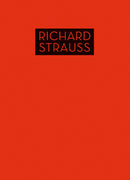| 作曲者 | Richard Strauss (1864-1949)・リヒャルト・シュトラウス |
| タイトル | Macbeth op. 23 |
| サブタイトル | (Zwei Fassungen und eigenhändiger Klavierauszug [2. Fassung]) |
| 出版社 | Verlag Dr. Richard Strauss |
| シリーズ名 | Richard Strauss Werke (Richard Strauss Works), Serie III: Symphonien und Tondichtungen, Richard Strauss Works, Band 4 |
| 楽器編成 | large orchestra |
| 楽器編成(詳細) | 3 (3. auch Picc.) · 2 · Engl. Hr. · 2 · Bassklar. · 2 · Kfg. - 4 · 3 · Bass-Trp. · 3 · 1 - P. S. (Beck. · Tamt. · kl. Tr. · gr. Tr.) - Str. |
| 品番 | 9790001164443 |
| 編曲者 | Stefan Schenk, Walter Werbeck |
| 形状 | 236 ページ・Hardback/Hard Cover |
| 演奏時間 | 18分 |
| 作曲年 | 1888-1891年 |
| 出版年 | 2017年 |
| 出版番号 | RSW 304 |
| ISMN | 9790001164443 |
| ISBN | 9783901974045 |
| その他 | complete edition |
Strauss’s first tone poem distinguishes itself from all other subsequent orchestral compositions in its existence in three different versions. Even among the operas and other compositions in his hand there is no other work with a comparable history of origin and publication. What is more, the final version of Macbeth is the only valid form of the work and the only variant with further sources (cf. Critical Report) in addition to the autograph score. In contrast, the second version has only been preserved in an autograph score and autograph piano reduction (the orchestral parts which must have existed have obviously not survived). This was never printed and was replaced by the published third version. The two surviving versions should therefore not be considered to be of equal status. Unlike the case of Ariadne auf Naxos in which the earlier version was for a time the sole valid alternative and was yet never completely displaced by the soon dominating later version of the opera, only the final third version of Macbeth is considered as valid. Right from the outset, it was a matter of course for the editors of the present volume to include the second version as a first publication (in addition to the above-mentioned surviving pages of the first version), albeit in different forms. The surviving pages of the first version are reproduced in facsimile and the second version, as a subordinate form of the work, appears alongside Strauss’s piano reduction in a modified source edition, i.e. without intervention on the part of the editors. The ultimate third version is published as a full edition (please refer to the Critical Report for further details). In order to facilitate a comparative study of the second and third versions, the relevant page numbers of the score are placed opposite one another (the autograph piano reduction of the second version is included at the end of the music section of the volume). The editors hope that this synoptic representation will prompt interest in further studies on Strauss’s art of orchestration: a field of research which has still remained insufficiently examined. A study of Macbeth namely illuminates as clearly as could be wished how much significance Strauss allotted to sound alongside form. The subjects were not merely intended to generate an individual figure, but also specific tonal colours, and the instrumentation was simultaneously designed to provide an optimal communication of thematic-motivic texture to the audience. The “new path” threw up consequences which caused Strauss a considerable amount of difficulty. He was however a fast learner and had already swum free with Don Juan and all the more with Tod und Verklärung.
Vorwort - Einleitung - Faksimile - Macbeth, 2. und 3. Fassung - Macbeth, Klavierauszug zur 2. Fassung - Macbeth, Fragmente der 1. Fassung - Kritischer Bericht - Macbeth, 3. Fassung - Macbeth, 2. Fassung - Macbeth; Klavierauszug zur 2. Fassung - Abkürzungen und Siglen



